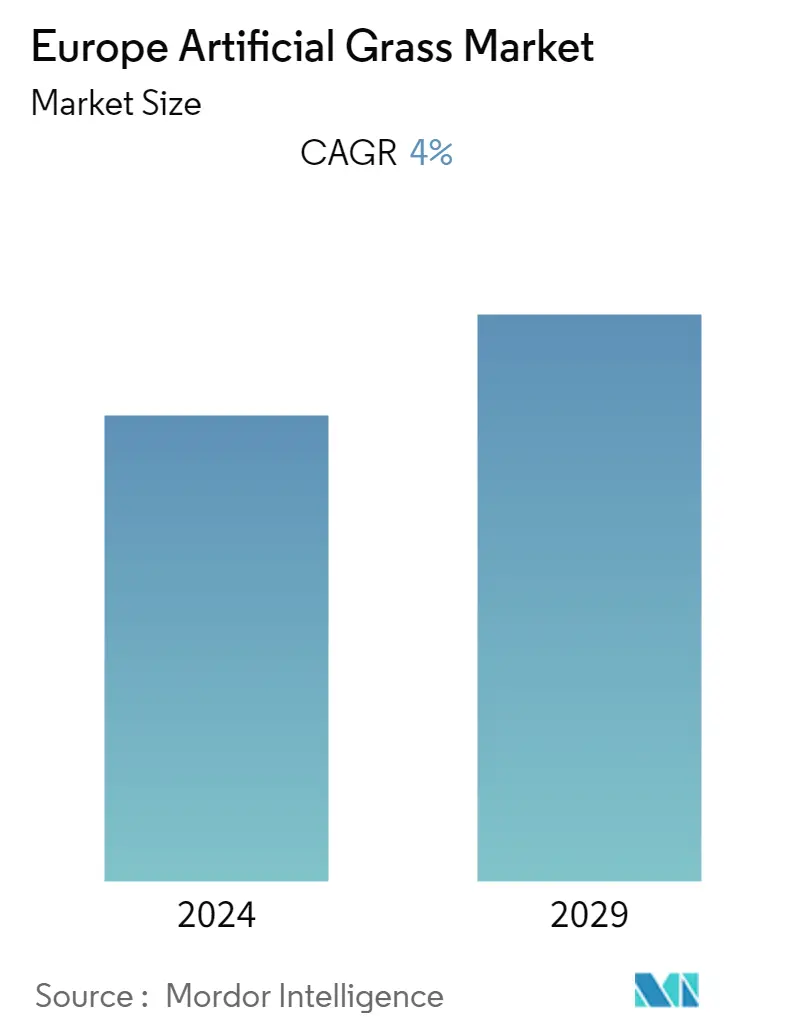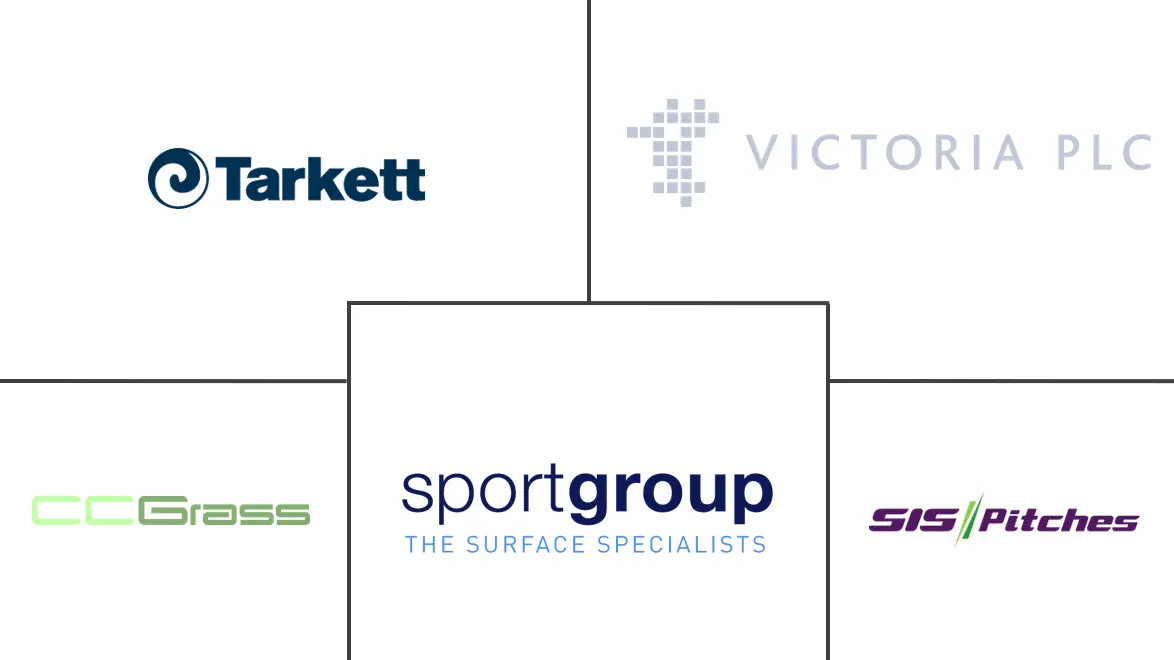Market Size of Europe Artificial Grass Industry

| Study Period | 2020 - 2029 |
| Base Year For Estimation | 2023 |
| Forecast Data Period | 2024 - 2029 |
| Historical Data Period | 2020 - 2022 |
| CAGR | 4.00 % |
| Market Concentration | Medium |
Major Players
*Disclaimer: Major Players sorted in no particular order |
Europe Artificial Grass Market Analysis
Europe Artificial Grass Market has generated a revenue of USD 850 million in the current year and is poised to achieve a CAGR of 4% for the forecast period.
In the base year 2021, Europe had a higher market share in the Worldwide artificial grass market. This is attributed to an increasing number of artificial grass sports field launches and the presence of major companies, such as Tarkett and TenCate Grass. A rising number of government and regulatory bodies' initiatives to enhance athletes' safety is driving revenue growth in the region.
In Europe, the COVID-19 pandemic took a significant bite out of the artificial grass market growth anticipated in the previous year. AMI Consulting tracked the industry closely through prior health and economic crises and expected the drive to recover by the following year. But by then, strong players will gain a more substantial market share while some weaker companies will be forced out of the market.
Many nations' stringent limits on the usage of infill material used in artificial grass are limiting the industry's progress. The European Chemical Agency (ECHA) suggested a six-year transition period to the European Union (EU) for banning synthetic granules used as filler in artificial turfs. This is projected to hinder the market's growth in several European countries. Although artificial grass does not burn, it melts quickly if exposed to bright reflected sunlight from any window or if something hot, such as charcoal, falls on it.
Europe Artificial Grass Industry Segmentation
Artificial grass is made of synthetic, man-made fibers that mimic the appearance of natural grass. These grasses are green in color and come in various pile heights. It is made the same way as carpet, with solid backing and the blades machine sewn on. Wall cladding and flooring are two types of fake grass installation procedures. Europe's Artificial Grass market is segmented by fiber base material (nylon, polypropylene, and polyethylene), by application (sports, residential, commercial, and other applications), and by country (Germany, United Kingdom, France, Italy, Spain, and the Rest of Europe). The report offers market size and forecast for the Europe artificial grass market in value (USD billion) for all the above segments.
| By Fiber-base Material | |
| Nylon | |
| Polypropylene | |
| Polyethylene |
| By Application | |
| Sports | |
| Residential | |
| Commercial | |
| Other Applications |
| By Country | |
| Germany | |
| United Kingdom | |
| France | |
| Italy | |
| Spain | |
| Rest of Europe |
Europe Artificial Grass Market Size Summary
The European artificial grass market is experiencing a steady growth trajectory, driven by an increasing number of sports field installations and the presence of major industry players like Tarkett and TenCate Grass. The region's market dominance is further supported by initiatives from government and regulatory bodies aimed at enhancing athlete safety. Despite the challenges posed by the COVID-19 pandemic, which temporarily hindered market expansion, the industry is poised for recovery. However, stringent regulations regarding the use of infill materials are presenting obstacles to growth, with the European Chemical Agency recommending a transition period for banning synthetic granules in artificial turfs. Innovations such as fire retardant and biodegradable artificial grass are opening new avenues for the market, offering environmentally friendly solutions that require minimal maintenance and enhance aesthetic appeal.
The renovation of sports fields and upgrades to facilities are significantly contributing to the market's expansion, with outdoor activities gaining popularity post-COVID-19 restrictions. A survey indicated a strong consumer interest in outdoor activities, further fueling demand for artificial grass. The market is characterized by the presence of prominent players, with a few companies holding significant market shares. However, technological advancements and product innovations are enabling both domestic and international companies to expand their market presence. Initiatives like TenCate Turf Recycling Solutions highlight the industry's focus on sustainability, while strategic acquisitions, such as Victoria's acquisition of Balta Group, are enhancing market reach and product offerings across Europe.
Europe Artificial Grass Market Size - Table of Contents
-
1. MARKET DYNAMICS AND INSIGHTS
-
1.1 Market Overview
-
1.2 Market Drivers
-
1.3 Market Restraints
-
1.4 Industry Attractiveness - Porters' Five Forces Analysis
-
1.4.1 Threat of New Entrants
-
1.4.2 Bargaining Power of Buyers
-
1.4.3 Bargaining Power of Suppliers
-
1.4.4 Threat of Substitutes
-
1.4.5 Intensity of Competitive Rivalry
-
-
1.5 Insights on Impact of Technology and Innovation in the Market
-
1.6 Impact of COVID-19 on the Market
-
-
2. MARKET SEGMENTATION
-
2.1 By Fiber-base Material
-
2.1.1 Nylon
-
2.1.2 Polypropylene
-
2.1.3 Polyethylene
-
-
2.2 By Application
-
2.2.1 Sports
-
2.2.2 Residential
-
2.2.3 Commercial
-
2.2.4 Other Applications
-
-
2.3 By Country
-
2.3.1 Germany
-
2.3.2 United Kingdom
-
2.3.3 France
-
2.3.4 Italy
-
2.3.5 Spain
-
2.3.6 Rest of Europe
-
-
Europe Artificial Grass Market Size FAQs
What is the current Europe Artificial Grass Market size?
The Europe Artificial Grass Market is projected to register a CAGR of 4% during the forecast period (2024-2029)
Who are the key players in Europe Artificial Grass Market?
Tarkett, Victoria PLC, Sport Group, SIS Pitches and Limonta are the major companies operating in the Europe Artificial Grass Market.

